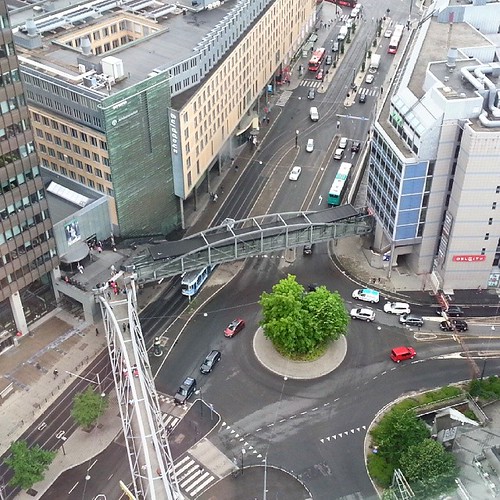

Oslo, that little brother of Nordic capitals, recently had elections that saw a shift from right to left. The new city council announced today their plan for the city in a number of areas. The most relevant for this article is the transport visions. And they are impressive. We know all too well that talk is cheap and political talk is often completely lacking in value, but the list for transforming Oslo is worth translating for a wider audience. Many cities have “plans” and it’s important to compare what is happening around the world.
While Oslo is lightyears behind Copenhagen, the city can be compared with Helsinki for it's level of bicycle urbanism and both of those capitals are certainly ahead of Stockholm. One of the key factors for Oslo's potential for growth is the simple fact that they have an office - actually two of them - dedicated to bicycle urbanism. Sykkelprojektet (The Bicycle Project) has eight employees and Sykkeplanseksjonen (Bicycle Plan Section) has about the same. Stockholm, for example, doesn't even have a dedicated bicycle office.
Infrastructure for bicycles in Oslo is few and far between. Most of it is just paint, which does nothing for anyone. Some of it is better. One of the primary challenges is that the Norwegian Road Directorate has calendars on their wall reading 1958. They are, indeed, one of the most backward road directorates in the world regarding lack of inclusion of facilities for bicycles in their standards. Giving the VicRoads ini the State of Victoria, in Australia, a run for their money. So it ain't easy in Oslo or other Norwegian cities.In 2012, the Ministry of Transport, hired Norconsult and Copenhagenize Design Co. to do a feasbility study about how to increase cycling levels in Norwegian cities. They were tired of the same, tired answers they had been getting from the Road Directorate and wanted a modern reply. A bold move. A good sign.
The key to growing urban cycling in Norway is allowing for Best Practice infrastructure to be built and updating the standards. THAT is the singlemost biggest hurdle facing the bicycle nation. At the moment, Oslo hangs about in the mid-50s on The Copenhagenize Index - out of 120 cities around the world. Now we turn our focus to Oslo and the promises laid out today by the new city council. We have placed them in the order that we think are most important/visionary. - Parking spots that are in conflict with bicycle infrastructure will be removed.--- (Brilliant. Getting this onto the books is the best way to expedite the development of infrastructure and urban cycling)
- Minimum 60 km of bicycle infrastructure i this period.
--- Modest goal. Could be better, but given the current level, it's a good number to start with. Although Buenos Aires put in 140 km in just two years so it seems low considering what is happening elsewhere) - Oslo must halve emissions by 2020.
--- (That is only five years away. Bold.)
- Oslo will be car-free within the Ring 1 road during that period.--- (Lots of cities talk about this. Let's see one do it)
- Removal of all free car parking spots in Oslo city centre. (Sounds like they will become paid parking, not removed)--- (Sounds like they will become paid, not removed, but still a bold move)
- 95% of all emissions will be gone by 2030.--- (Did they say NINETY-FIVE PERCENT? We'll believe it when we see it, but it's a great vision)
- New Metro tunnel--- (A good investment to add to the existing network and provide alternatives)
- Car traffic will be reduced by 20% in this period.--- (Seems like a low number, based on the points above)
- No extension of the E18 motorway to the west.--- (Of course not. It was the stupidest idea in Norway)
- Rush hour fee for motorists, in collaboration with Akershus.--- (Extra fee on the existing congestion charge. Not bad at all)
- Oslo City will remove all its investments in companies that produced fossil fuel energy.--- (Great symbolism)
- Subsidies for e-bike sales.--- (Doing all of the above and then slapping more fast-moving vehicles on the streets is not exactly the right way to go about it. If they are forced to use the road and not the bicycle infrastructure, fine.
All good. All interesting. Let's just see what Oslo does with it.



